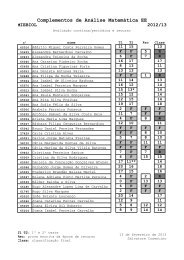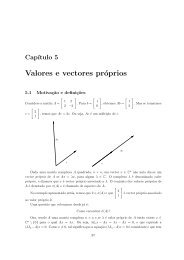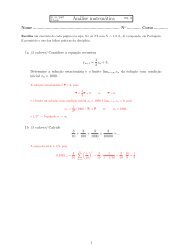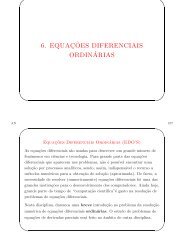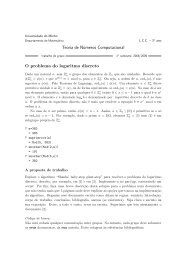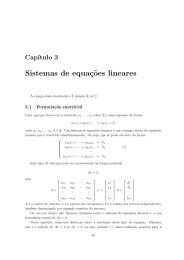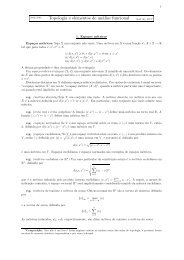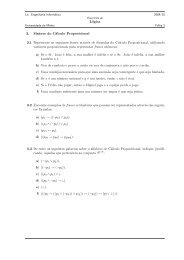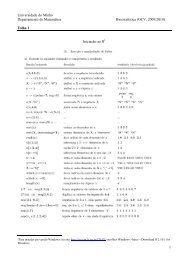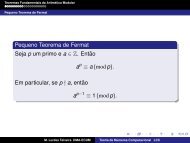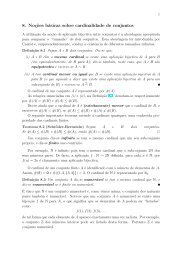My title - Departamento de Matemática da Universidade do Minho
My title - Departamento de Matemática da Universidade do Minho
My title - Departamento de Matemática da Universidade do Minho
Create successful ePaper yourself
Turn your PDF publications into a flip-book with our unique Google optimized e-Paper software.
10 STATISTICAL DESCRIPTION OF ORBITS 64<br />
exterior measure (it is very easy to produce exterior measures, for example by means of variational<br />
principles) and then check that the σ-algebra of measurable sets is sufficiently big for our purpose.<br />
The i<strong>de</strong>a of Carathéo<strong>do</strong>ry is the following. A probability measure on an algebra A of subsets<br />
of X is an additive function m : A → [0, 1] such that m (∅) = 0, m (X) = 1, and such that A n ↓ ∅<br />
implies m (A n ) ↓ 0. Given a probability measure m on a algebra A , the recipe<br />
{∑ }<br />
µ (S) = inf m(An ) with S ⊂ ∪ n A n e A n ∈ A<br />
<strong>de</strong>fines an exterior measure on P(X), hence the above construction produces a measure µ on the<br />
σ-algebra of µ-measurable sets, which contains A and so contains σ (A). One then checks that<br />
µ (A) = m (A) for any A ∈ A, so that µ is an “extension” of the measure m. Carathéo<strong>do</strong>ry’s<br />
extension theorem is then stated in the following form:<br />
Carathéo<strong>do</strong>ry’s extension theorem . Given a probability measure m on a algebra A of<br />
subsets of X, there exists a unique measure µ on σ (A) which extends m.<br />
The following corollary of Carathéo<strong>do</strong>ry’s theorem is also useful, for example when trying to<br />
prove that some event has a <strong>de</strong>finite probability.<br />
Approximation theorem . Let (X, E, µ) be a probability space, and let A be an algebra of<br />
subsets of X such that σ (A) = E. Then, for any A ∈ E and any ε > 0, we can find a A ε ∈ A<br />
such that<br />
µ (A∆A ε ) < ε.<br />
In<strong>de</strong>ed, one easily sees that the family C = {A ∈ E s.t. ∀ε > 0 ∃A ε ∈ A s.t. µ (A∆A ε ) < ε} is<br />
a σ-algebra. Since A is obviously contained in C, this implies that E =σ (A) ⊂ C ⊂ E.<br />
Lebesgue measure. The collection I of intervals of the real line is a semi-algebra, i.e. the<br />
intersection of two elements of I is in I and the complement of an element of I is a union of<br />
elements of I. The function m : I → [0, ∞], <strong>de</strong>fined as m ([a, b]) = |b − a| if a e b are finite, and<br />
∞ if the interval is unboun<strong>de</strong>d, is monotone and gives value zero to the empty set. Postulating<br />
additivity, the function m extends to a measure on the algebra A ma<strong>de</strong> of disjoint unions of<br />
elements of I (this is not trivial!, the proof uses the Heine-Borel theorem about compact subsets<br />
of the real line). The function µ : P(R) → [0, ∞], <strong>de</strong>fined as<br />
{∑ }<br />
µ (E) = inf m(Cn ) with E ⊂ ∪ n C n e C n ∈ A<br />
is then an exterior measure on the real line. The σ-algebra L of µ-measurable sets, called Lebesgue<br />
σ-algebra, contains the Borel sets, because it contains the intervals. The restriction l = µ | L , as<br />
well as µ ∣ ∣ B(R) , is called Lebesgue measure.<br />
Observe that Lebesgue measure on the real line is not a probability measure, having infinite<br />
mass. Nevertheless, one can easily <strong>de</strong>fine probability measures on boun<strong>de</strong>d intervals taking<br />
normalized restrictions of Lebesgue measure. For example, take X = [0, 1], and E = B (X) =<br />
{X ∩ B with B ∈ B (R)}, the Borel subsets of the interval. The restriction of l to E is a probability<br />
measure, called Lebesgue measure on the unit interval.<br />
The very same construction works in R n , starting with the semi-algebra of “rectangles” measured<br />
by the “eucli<strong>de</strong>an volume”, and produces a measure l on B (R n ), also called Lebesgue measure.<br />
Lebesgue measure is the unique measure over the Borel sets of the eucli<strong>de</strong>an space which is invariant<br />
un<strong>de</strong>r traslations, i.e. l (λ + B) = l (B) for any λ ∈ R n and any Borel set B, and which is<br />
normalized to give measure one to the unit square, i.e. l ([0, 1] n ) = 1.<br />
The axiom of choice allows one to “give examples” of subsets wich are not Lebesgue-measurable<br />
(for example, the set ma<strong>de</strong> of one point for each orbit of an irrational rotation of the circle).<br />
The following result is useful (see [Mat95] for a proof). Below, B ε (x) = {y ∈ R n s.t. ‖x −<br />
y‖ 2 < ε} <strong>de</strong>notes the open ball of radius ε > 0 and center x ∈ R n w.r.t. the Eucli<strong>de</strong>an distance<br />
‖x − y‖ 2 2 = ∑ n<br />
i=1 |x i − y i | 2 .



